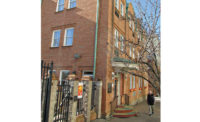Bruce Weiss, Chuck Egan and many others literally had a blast with the design and construction of the new addition to the Nemours/A.I. DuPont Hospital for Children in Wilmington, Del.
Neither Weiss, the project engineer from Madison, Wis.-based Affiliated Engineers who designed the project, and Egan, the hospital’s MEP project manager, had ever been involved with a project that required the use of explosives. So, they and the rest of the project’s team made sure to let the children — many of whom are struggling with serious illnesses — “take part” in the controlled explosions.
“Several children ‘helped’ with the blasting,” Egan recalls. “The superintendents built a box with a plunger — sort of like you would see in a Road Runner cartoon — and they had a whole coordinated effort so when a kid would push down on the plunger that is when they would do the blasting.
“It was really neat and the kids enjoyed that very much.”
Additionally, there were some balconies on the third floor of the existing building where kids and their families could get a bird’s-eye view of the construction. And if the kids wanted to get up close and personal, they had some vantage points on the ground level.
“We had a safety fence around our main entrance,” Egan states. “It was a hard fence, but we installed view portals into it at a kid’s height so they could peer into the site and see what was going on.”
What was going on was the $215 million expansion of a premier children’s hospital, ranked by U.S. News & World Report and awarded one of the Leapfrog Group’s top children’s hospitals in 2012. The new construction is a five-story building built in a semicircular design. Weiss, Egan and the hospital’s owners decided to utilize copper for the plumbing and medical gas needs throughout the building.
Weiss — who specializes in the design of medical facilities — recalls copper was not the first thought for the DuPont facility.
“Copper is king,” he says. “There was a time when we were looking at PEX, but we did not want to go with that because we know about the longevity of copper. The other reason was because of the self-sanitizing attributes of copper. We felt that was important.”
Since the plastic and black steel pipe would not meet the criteria for DuPont, the team called in the Copper Development Association to ensure copper could handle the load. The CDA worked alongside Weiss and Egan to validate that they were not harming the integrity of the piping and were not going to have a negative impact on the system. The group worked together for two months reviewing the design and then once the installation started, confirmed everything was in order.
“That really put a lot of minds at ease,” Egan says. “There were some concerns that bending would hurt the integrity of the piping. We wanted to do our due diligence.”
The copper tubing covers the domestic hot and cold water — which include Patterson Kelly heat exchangers — demands, HVAC needs and the medical gas distribution. But with a project of this size and the uncommon architecture, the work was just beginning.
In the details
The DuPont building is now two towers that from the outside look identical, but Weiss states that is not the case.
“They are close, but they are not that close,” he says. “That created its own challenges and a lot of the design basics (from the original building) translated, but the minutiae did not when we were laying it out.”
The new building has a large piping loop that runs around the outside of the patient rooms, followed by a more standard plumbing layout for the patient rooms. Additionally, the building has very high ceilings and they vary in total height from area to area. Weiss says the height of the standard bathroom ranges from 8 to 9 ft. depending if it is ADA-compliant; a patient’s room is 9 ft. and every common area (also known as “pocket parks” to Weiss) is 12 ft.
“There was a lot of jumping of the pipe. And the coordination of that proved to be difficult among the multiple trades,” Weiss says. “And it became very difficult with the storm piping because that pipe is of their size and locations.”
Weiss says the team treated each of the pocket parks as a module of eight rooms and each floor has 24 patients. And even though the pocket parks have a high ceiling, they do have a large void which was used for most of the chases for the vertical piping.
“The piping was run as loops with a main outer loop that supplies the domestic hot and cold water for the patient’s rooms,” Weiss states. “Also, in a patient’s room there is an inner loop for the staff and nurses’ sinks. So we put a return on each of those loops which was a good way to break it up so the design was not ‘valve heavy.’ This way we could balance the returns efficiently. The main loop also lent itself to the efficient piping of the prefabricated toilet modules.”
Weiss says that the use of building information modeling was “one of the strong things that made the building possible.” In the irregularly-shaped kitchen, for example, there were times when Weiss could not get the run of pipe that he wanted, so he had to create drop locations – sometimes where the wall tapered a bit or by the doorway.
“We were able to see when we were below a ceiling and what we needed to do,” he recalls. “We were able to divide the long runs of the building drain pipes and negotiate where we could drop chases that were architecturally pleasing.”
Egan estimates there are around 400 electronic fixtures throughout DuPont and they had to work on an issue of having debris clog up the Watts Water check valves and backflow preventers. That allowed for cold water to bleed through.
“We had the contractors blitz in right before the opening of the hospital and add spring checks,” Egan says. “Those were added at all the drops for all electronic faucets.”
Putting it together
With a project of this size and the amount of coordination needed to make the design and construction run smoothly, the team felt it was in its best interests to prefabricate as much of the copper pipe as possible. The primary reason to prefab the pipe was because the copper had to bend so it could wrap around the football-shaped additions.
The plumbing modules for the bathrooms and medical gas system were prefabricated in a warehouse 10 miles away from DuPont Children’s Hospital. Egan estimates the addition was completed six months earlier than it could have been by not prefabricating the pipe.
The MEP racks were created in 10-ft. sections and then 20 ft. was lifted and put into place throughout the corridors. Egan states that if the hospital chose to not use copper for the system, it would have needed to add a significant amount of additional fittings. This would have hindered all aspects of the project.
“That would have increased cost, time and the system’s performance would have been impacted negatively,” Egan says. “The fact that we were able to extend the length of copper pipe and bend it to match the curvature of the building saved significant time and money.”
He adds: “Prefabrication gives you interesting perspective on quality control and reviewing an installation. We were able to mock up one MEP rack and get that rack 100% so me, (Weiss) and everyone else were fully satisfied with the product we were receiving. Then we were able to duplicate that 250 or however many times we needed to.”
Eye on the environment
Egan states DuPont Hospital for Children is in the early stages of applying for LEED Silver certification. There are American Standard high-efficiency toilets, lavs and low-flow Delta Faucet fixtures installed throughout the building.
DuPont has a rainwater harvesting system that captures the clearwater waste and the natural rainwater and repurposes it for the irrigation for the campus grounds. There are two underground collection tanks, but the pumps for that system are not in the building. Weiss found that the Wilmington region has very strong codes regarding clearwater waste.
“In that community, they are very firm codes about not discharging clearwater waste into sanitary systems,” he says. “That is because their sewage treatment system is maxed out. That is one of the few absolute rules.”
Weiss recalls when the project was simply going to be a 150,000-sq.-ft. addition to the original building. Then the brass at Nemours went back to the drawing board and then kicked it into another gear.
“Someone said, ‘If we are going to build something, let’s really building something,” Weiss recalls. “This is one of the most exciting projects I’ve ever worked on and it is an incredibly dramatic structure when you are in it.”
Five years later, it came time to move the patients from existing tower into the new building, Egan was pleased he could come out from his office and take part in the excitement.
“After all the hard work and hours the team put in, that patient move day for me was a lot of fun,” he says. “I took control of two elevators and we took patients to where they were going to. As an MEP guy, I do not get to interact with the patients much. It was neat to watch the patients’ and their families’ faces as they entered the building.
“It’s been nice to take people through and brag a little bit about the project.”
HELPFUL LINKS:






